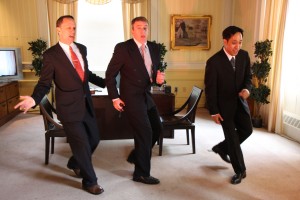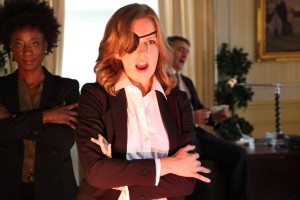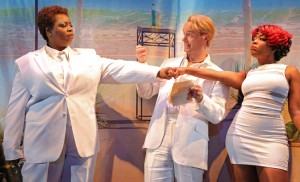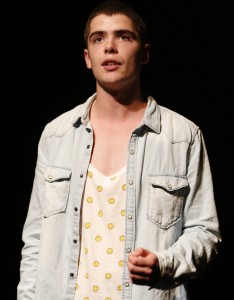If you thought Governors Island was only for bicycling, picnics and electronic music concerts — think again! Because theater visionaries David Evans Morris and Kristin Marting have transformed the island's historic Pershing Hall into a "living market" for their latest immersive theater creation entitled Trade Practices, which kicks off the 2014-15 season at HERE Arts Center. Like our nation's economy, Trade Practices is intricately structured and impossible to wrap your head around. The rooms of Pershing Hall have been transformed into departments of a fictional currency-printing corporation, Tender, Inc. Each audience member receives a roll of cash and, accordingly, the power to invest their time and "money" into whichever storyline they choose. Part of the fun and frustration of Trade Practices (and immersive theater in general) is knowing that every audience member's experience must be different, and that one can't possibly see or experience everything.
By dividing the threads of action into separate spaces, Marting and Morris have created for themselves an unprecedented freedom to play with style and form. Within each plot line, the collaborators dive enthusiastically into genres such as satire, participatory theater, dance, melodrama, musical theater, and so much more. More emphasis is placed on unity of theme or thought than stylistic or aesthetic unity (as in Punchdrunk's cinematic behemoth of immersive theatre, Sleep No More). Yet this schizophrenia of style works wonderfully for the piece, ensuring that audience members are never, ever bored and never, ever sure what is going to come next.
A particularly charming stylistic tangent is the musical numbers performed in the "Owners" story line, as well as every incident of full-ensemble choreography that takes place on the trade floor, where the entire audience convenes between each plot episode. These dance numbers smack of the virtuosic yet amateurish choreography of Elevator Repair Service productions, as well as the quirkily empowered dance moments in the work of Young Jean Lee (no surprise since Trade Practices incorporates actors and collaborators from both). Fully committed to the song and dance, the brilliant ensemble cast is present at every moment — be it wacky, heartfelt or politically charged.
The complexity and thought behind the text of Trade Practices (written by Eisa Davis, Robert Lyons, Erin Courtney, Qui Nguyen, KJ Sanchez, and Chris Wells) indicates some serious dramaturgy and research, and the program indicates a bevy of bankers and financial workers that lent their knowledge to the project. There are times, however, that the finance-speak becomes overwhelming for those of us without a banking background. Rather than weighing down the piece, however, these moments only serve to enhance the feeling of intricacy and insurmountability of the economy — a formidable beast of our own creation. For audience members who are finance-savvy, the moments of intense economic debate are likely to be stimulating. Regardless, Trade Practices manages to unmask the relationship between money, power and the human condition. The results are messy, but undoubtedly thought-provoking (and worth the ferry ride to Governors Island).
Trade Practices ran until Sept. 21 at HERE Arts Center (145 Avenue of the Americas). For more information, please visit www.here.org.





































